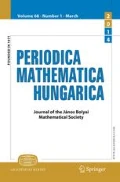Abstract
Let n be a nonzero integer. A set of m distinct positive integers is called a D(n)-m-tuple if the product of any two of them increased by n is a perfect square. Let k be a positive integer. In this paper, we show that if {k 2, k 2+1, c, d} is a D(−k 2)-quadruple with c < d, then c = 1 and d = 4k 2+1. This extends the work of the first author [20] and that of Dujella [4].
Similar content being viewed by others
References
A. Baker and H. Davenport, The equations 3x 2 − 2 = y 2 and 8x 2 − 7 = z 2, Quart. J. Math. Oxford Ser. (2), 20 (1969), 129–137.
A. Dujella, Generalization of a problem of Diophantus, Acta Arith., 65 (1993), 15–27.
A. Dujella, The problem of the extension of a parametric family of Diophantine triples, Publ. Math. Debrecen, 51 (1997), 311–322.
A. Dujella, Complete solution of a family of simultaneous Pellian equations, Acta Math. Inform. Univ. Ostraviensis, 6 (1998), 59–67.
A. Dujella, On the exceptional set in the problem of Diophantus and Davenport, Applications of Fibonacci Numbers, 7 (1998), 69–76.
A. Dujella, An extension of an old problem of Diophantus and Euler, Fibonacci Quart., 37 (1999), 312–314.
A. Dujella, An absolute bound for the size of Diophantine m-tuples, J. Number Theory, 89 (2001), 126–150.
A. Dujella, An extension of an old problem of Diophantus and Euler. II, Fibonacci Quart., 40 (2002), 118–123.
A. Dujella, There are only finitely many Diophantine quintuples, J. Reine Angew. Math., 566 (2004), 183–214.
A. Dujella, A. Filipin and C. Fuchs, Effective solution of the D(−1)-quadruple conjecture, Acta Arith., 128 (2007), 319–338.
A. Dujella and C. Fuchs, Complete solution of a problem of Diophantus and Euler, J. London Math. Soc., 71 (2005), 33–52.
A. Dujella and A. Pethő, A generalization of a theorem of Baker and Davenport, Quart. J. Math. Oxford (Ser. 2), 49 (1998), 291–306.
A. Dujella and A. M. S. Ramasamy, Fibonacci numbers and sets with the property D(4), Bull. Belg. Math. Soc. Simon Stevin, 12 (2005), 401–412.
A. Filipin, There does not exist a D(4)-sextuple, J. Number Theory, 128 (2008), 1555–1565.
A. Filipin and Y. Fujita, The D(-k 2)-triple {1, k 2+1, k 2+4} with k prime, Glas. Mat. Ser. III, 46 (2011), 311–323.
A. Filipin, B. He and A. Togbé, On the D(4)-triple {F 2k , F 2k+6, 4F 2k+4}, Fibonacci Quart., 48 (2010), 219–227.
A. Filipin, B. He and A. Togbé, On a family of two-parametric D(4)-triples, Glas. Mat. Ser. III, to appear.
Y. Fujita, The non-extensibility of D(4k)-triples {1, 4k(k − 1), 4k 2 + 1} with |k| prime, Glas. Mat. Ser. III, 41 (2006), 205–216.
Y. Fujita, The extensibility of Diophantine pairs {k−1, k+1}, J. Number Theory, 128 (2008), 322–353.
Y. Fujita, Extensions of the D(∓k 2)-triples {k 2, k 2 ± 1, 4k 2 ± 1}, Period. Math. Hungar., 59 (2009), 81–98.
Y. Fujita, The number of Diophantine quintuples, Glas. Mat. Ser. III, 45 (2010), 15–29.
B. He and A. Togbé, On a family of Diophantine triples {k,A 2 k +2A, (A+1)2 k + 2(A + 1)} with two parameters, Acta Math. Hungar., 124 (2009), 99–113.
B. He and A. Togbé, On a family of Diophantine triples {k,A 2 k +2A, (A+1)2 k + 2(A + 1)} with two parameters II, Period. Math. Hungar., 64 (2012), 1–10.
S. P. Mohanty and A. M. S. Ramasamy, The simultaneous Diophantine equations 5y 2 − 20 = x 2 and 2y 2 + 1 = z 2, J. Number Theory, 18 (1984), 356–359.
Author information
Authors and Affiliations
Corresponding author
Additional information
Communicated by Attila Pethő
Rights and permissions
About this article
Cite this article
Fujita, Y., Togbé, A. The extension of the D(−k 2)-pair {k 2,k 2 + 1}. Period Math Hung 65, 75–81 (2012). https://doi.org/10.1007/s10998-012-2912-x
Received:
Accepted:
Published:
Issue Date:
DOI: https://doi.org/10.1007/s10998-012-2912-x


